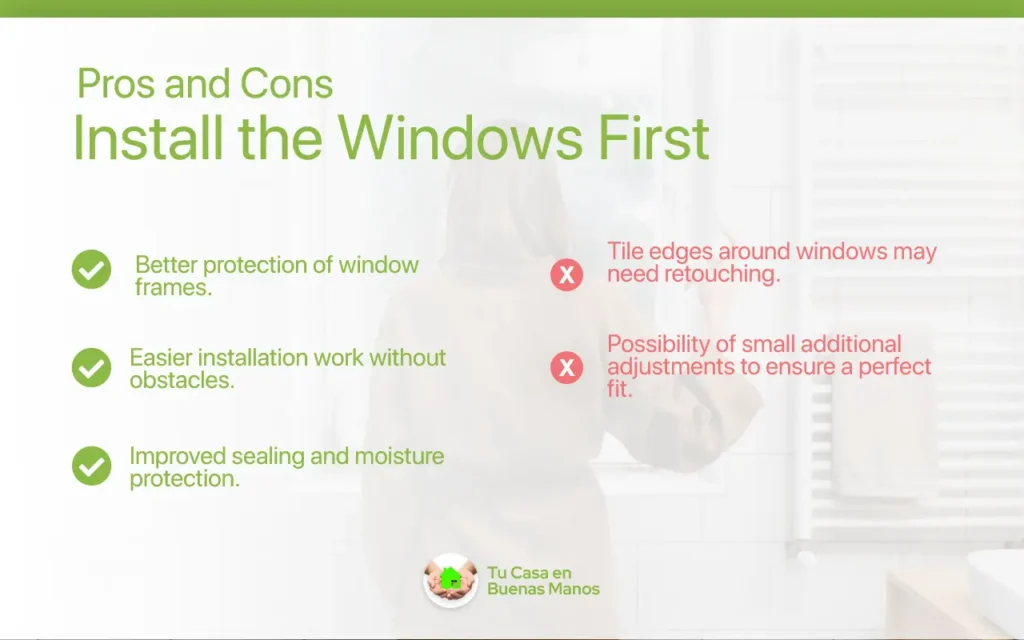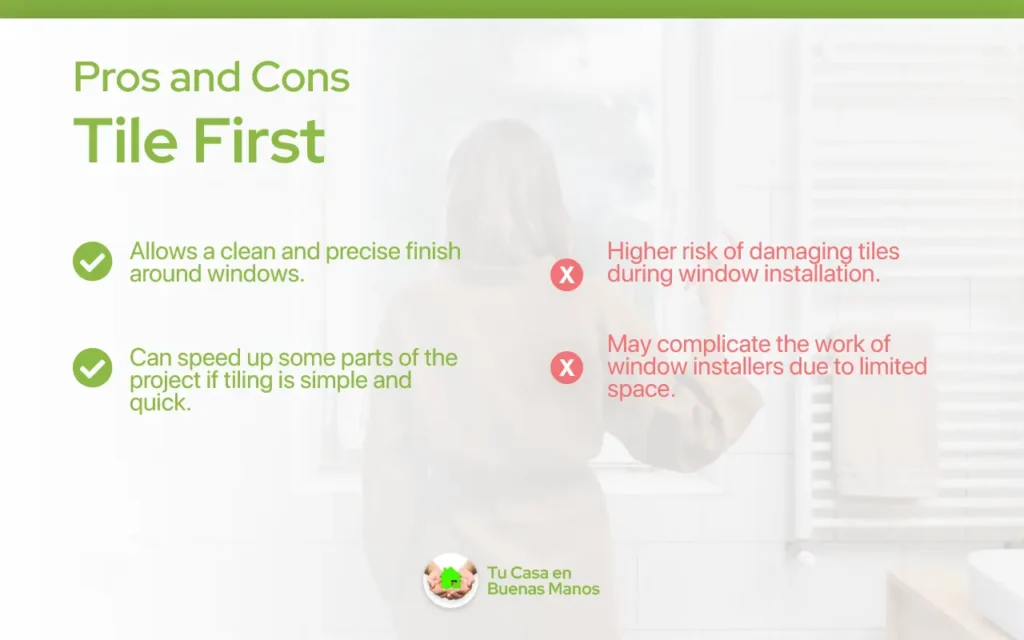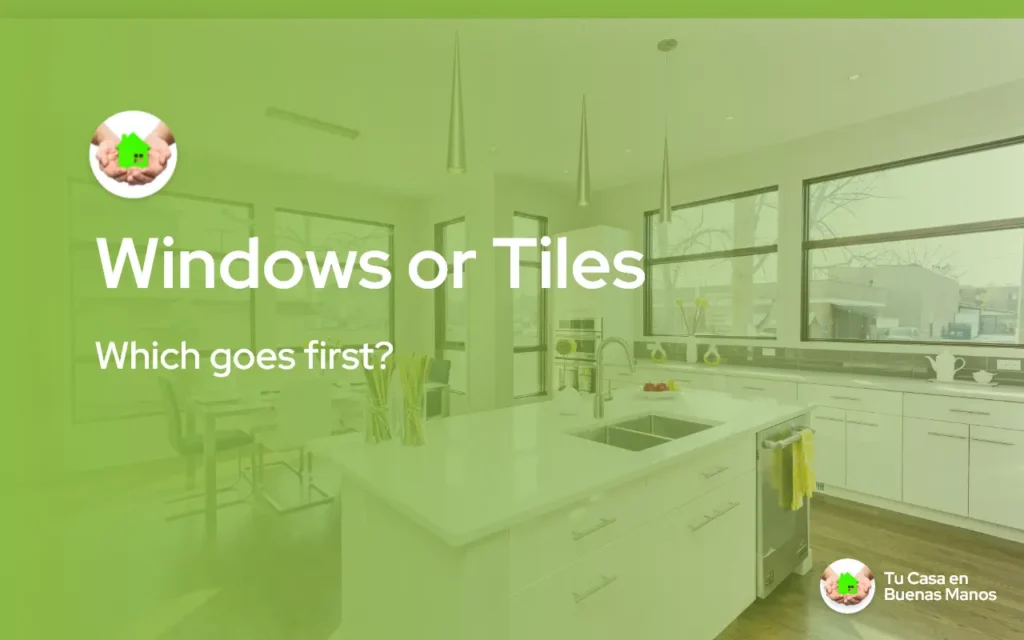When it comes to home renovations, one of the most common questions is: What should be installed first, windows or tiles? This is a crucial aspect to ensure a smooth and successful renovation. In this article, we will delve into this topic, exploring the pros and cons of each approach and offering recommendations based on personal experiences and industry best practices.
The Importance of Order in Renovations
The order in which different tasks are carried out in a renovation can significantly impact the final result. Placing elements in the right sequence not only saves time and money but also helps avoid damage and ensures a longer-lasting, more aesthetic installation.
Window Installation: When Is the Best Time?
Installing windows is a fundamental step in any renovation. Ideally, windows should be installed before tiling for several reasons:
- Damage Prevention: Installing the windows first avoids damaging the frames or glass during tile placement.
- Proper Sealing: Windows installed beforehand allow for better sealing against moisture and weather, ensuring no leaks that could damage the tiles.
- Ease of Work: Without tiles in place, window installers have more room to work, which often results in a more precise installation.
Personal experience: I recall a renovation where, based on the contractor’s advice, we decided to install the windows after tiling. It was a disaster: dust and debris from the window installation scratched several tiles, which we then had to replace—raising both costs and timelines.

Installing Windows First: Pro Tips and Common Mistakes
If you choose to install the windows before tiling, you’re following the most common industry recommendation—but even then, details matter. Here are some key tips to make this approach work smoothly:
Pro Tips
- Protect window frames during tiling: Use painter’s tape or masking film to shield the frames from grout splashes and tile adhesive.
- Account for tile thickness: When placing the windows, leave a margin to accommodate the thickness of the tiles and allow for proper silicone sealing.
- Use high-quality waterproof sealants: Especially in bathrooms and kitchens, ensure the perimeter of the window is well-sealed before tiles go in.
Common Mistakes to Avoid
- Installing flush with the wall: If the window is installed too tight without room for tiles, you may need to trim tiles awkwardly or compromise the finish.
- Neglecting expansion gaps: Always leave enough room for materials to expand, especially in areas with temperature and humidity fluctuations.
Pro insight: Many professional builders recommend this sequence in moisture-prone areas like bathrooms, as it allows for stronger, long-term sealing and fewer maintenance issues.

Tiling First: When It Makes Sense and How to Do It Right
While not the standard, tiling first can work well in certain scenarios—especially when your window opening is already set and you want a seamless edge finish.
When It Makes Sense
- You’re replacing tiles, not windows: If the windows are staying in place, you can tile around them for a refreshed look.
- Custom window frames: Some modern window systems are designed to sit on top of tiled edges for a flush, minimalist style.
- Tiling is quick and simple: In some small renovations, it can make sense to tile first and bring in windows after with proper protection.
How to Prevent Problems
- Cover tiles fully before window installation: Use cardboard or foam board to avoid chips or scratches during frame installation.
- Coordinate measurements carefully: Ensure that the window frame will fit perfectly with the existing tile line—no adjustments should be needed on-site.
- Avoid last-minute improvisation: If window installers are not informed early, they may use tools or adhesives that can damage finished surfaces.
Personal lesson: On a previous job, tiling first seemed like the fast-track choice. But we spent hours masking and shielding the tiles, and still ended up with chipped corners. Now I always double-check the trade-off.
Where to Place the Pros and Cons Table
| Install windows first | Tile first | |
|---|---|---|
| Pros |
|
|
| Cons |
|
|
Personal Experience and Recommendations
From my experience with various renovations, I’ve learned that installing windows first generally results in a cleaner and more efficient project. For instance, in a recent bathroom renovation, we followed this sequence and avoided many common issues. The window installers worked freely without worrying about damaging the tiles, and the final tiling came out flawless.
I recommend that anyone planning a renovation consider their specific needs and consult with professionals. While installing windows first is usually the safest choice, every project has its own nuances that may influence the final decision.
Final Thoughts
Deciding whether to install windows or tiles first is an important choice that can greatly affect the success of a renovation. While installing the windows first offers multiple benefits in terms of protection and ease of installation, tiling first also has its merits—especially in achieving a neat finish. Based on personal experience and standard practice, installing windows first tends to be the most effective and safest option. However, it’s always wise to evaluate each situation individually and make an informed decision to ensure the best possible results in your renovation.
- Ready-to-Rent on the coast: how to renovate to rent better with less maintenance - October 20, 2025
- What renovation increases resale value the most in apartments near the coa - October 19, 2025
- How much does it cost to renovate a luxury bathroom? - September 16, 2025




